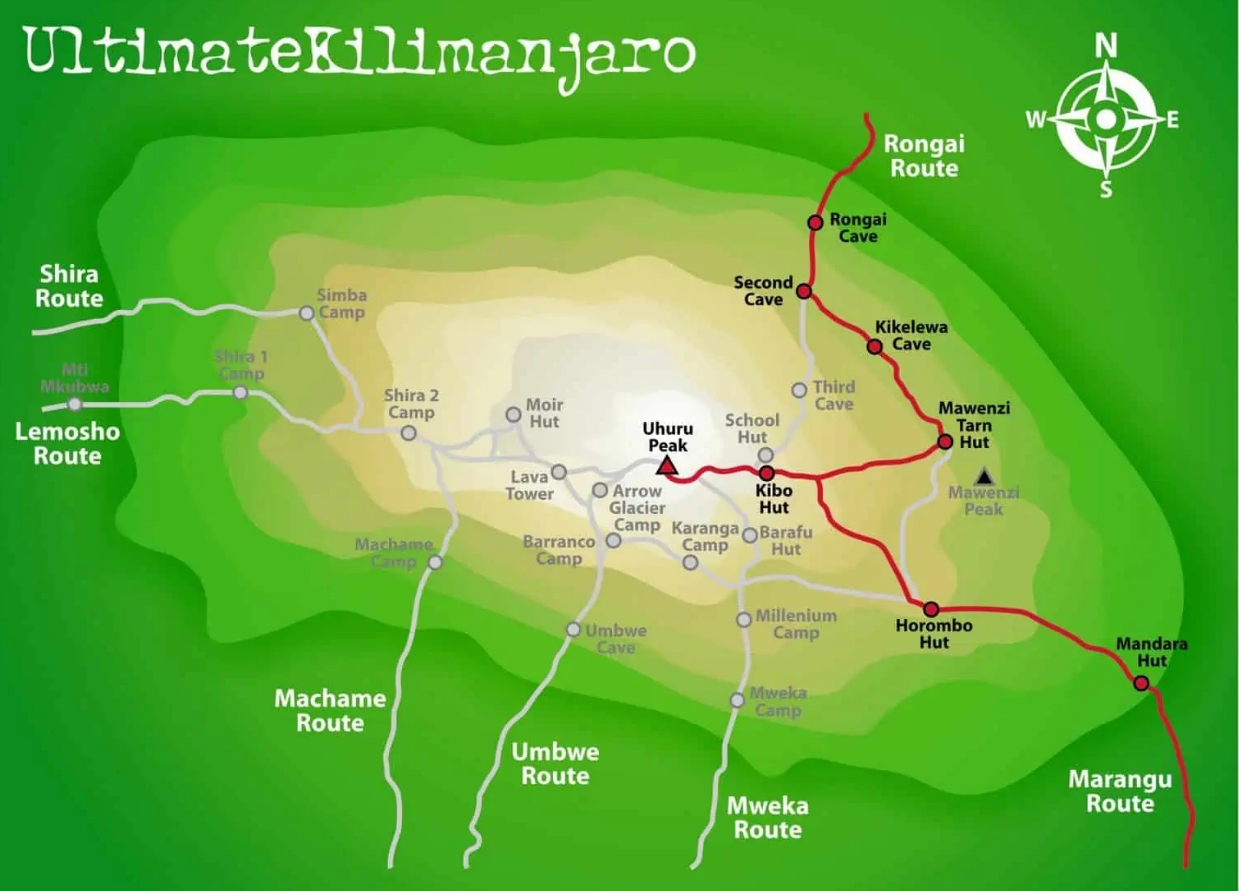RONGAI ROUTE KILIMANJARO
| Minimum travellers | 2 |
| Maximum travellers | 10 |
Itinerary
-
1
Arrive and transfer to hotel
Upon arrival at your destination, you will proceed to transfer to the hotel where you will spend the night. This will be the starting point of your adventure, providing you with the opportunity to rest and prepare for the days ahead.
2Rongai Gate (1950m) - 1st Caves camp (2600m)
After breakfast, you will head to the Rongai Gate, which is situated at an altitude of 1950 meters. From there, your journey will take you to the 1st Caves camp, located at a higher elevation of 2600 meters. This day will involve a trek through scenic landscapes as you acclimatize to the altitude while enjoying the natural beauty surrounding you.
3First Cave (2600m) - Kikelewa Cave (3600m)
On this day, your hike will continue from the First Cave at 2600 meters to Kikelewa Cave, which is situated at 3600 meters. This portion of the trek will allow you to experience varied terrains, alongside breathtaking views that emphasize the grandeur of the mountains.
4Kikelewa Cave (3600) - Mawenzi Tarn camp (4330m)
The journey progresses from Kikelewa Cave at 3600 meters to Mawenzi Tarn camp, located at an elevation of 4330 meters. As you climb higher, you will witness remarkable changes in the environment, including unique flora and fauna, all while preparing your body for the altitude.
5Mawenzi Tarn camp (4330m) - Kibo hut (4700m)
From Mawenzi Tarn camp at 4330 meters, you will embark on a hike to Kibo hut, which stands at an altitude of 4700 meters. This section of the trek will challenge your endurance, but the stunning vistas will serve as motivation to keep moving forward.
6SUMMIT ATTEMPT Kibo hut (4700m) - Uhuru Peak (5895m) - Horombo hut (3720m)
This day marks a significant milestone in your expedition as you attempt to reach the summit. Starting early from Kibo hut at 4700 meters, you will aim for Uhuru Peak, the highest point at 5895 meters. After reaching the peak, you will descend to Horombo hut, located at 3720 meters, which allows for a well-deserved rest after a demanding ascent.
7Horombo hut (3720m) - Marangu Gate (1980m)
The descent continues from Horombo hut at 3720 meters to Marangu Gate, situated at an altitude of 1980 meters. This final stretch of your trek will take you through lush forests, providing a scenic backdrop as you make your way back down.
8Final Departure
On the final day of your adventure, you will prepare for departure. This day will involve concluding your experience, reflecting on the journey taken, and cherishing the memories created during the trek.
Services
Cost Includes
-
- Park Fees: This usually covers Kilimanjaro National Park entry fees, camping or hut fees, and rescue fees.
- Mountain Crew: Salaries and support for experienced, English-speaking guides, assistant guides, cooks, and porters. The number of crew members often depends on the group size.
- Meals: Three meals a day (breakfast, lunch, and dinner) are typically provided while on the mountain, prepared by the cook.
- Accommodation on the Mountain: This includes the use of camping equipment such as tents and sleeping mats. Some operators might offer upgrades for sleeping bags and more comfortable pads for an extra fee.
- Transportation: Transfers to and from Kilimanjaro International Airport (JRO) to your hotel in Moshi or Arusha, and transportation from your hotel to the Lemosho route starting point (Londorossi Gate) and back after the trek.
- Safety Equipment: Reputable operators often provide safety equipment such as oxygen cylinders, pulse oximeters for monitoring altitude sickness, and comprehensive first-aid kits. Some may also include portable toilets.
- Camping Equipment: Group camping gear like dining tents with tables and chairs, cooking equipment, and eating utensils are usually included.
- Hotel Accommodation: Many packages include accommodation in a hotel in Moshi or Arusha for the night before the climb and the night after the descent, often on a bed and breakfast basis.
- Government Taxes: This may include Value Added Tax (VAT) as charged by the Tanzanian government.
Cost Excludes
-
- International and Domestic Flights: The cost of your flights to and from Tanzania is usually not included.
- Tanzanian Visa: You will likely need to obtain a tourist visa to enter Tanzania, and the cost of this is typically not included in the trekking package. The fee can vary depending on your nationality.
- Travel Insurance: It is highly recommended and often mandatory to have comprehensive travel insurance that covers medical expenses, emergency evacuation (including helicopter rescue, if possible), trip cancellation, and other potential risks associated with high-altitude trekking.
- Tips for the Mountain Crew: Tipping guides, assistant guides, cooks, and porters is a customary and expected part of the Kilimanjaro climbing experience. The amount is usually recommended per day per crew member and is not included in the upfront cost.
- Personal Gear: You will need to bring your own personal trekking gear, including clothing layers, waterproof jacket and pants, hiking boots, a sleeping bag (some operators offer rental), trekking poles, a headlamp, and other personal items.
- Meals and Drinks Not Specified: Meals at the hotel before and after the climb (other than breakfast if included) and any drinks other than water provided on the mountain (such as bottled water, soft drinks, or alcoholic beverages) are usually at your own expense.
- Personal Expenses: Items of a personal nature, souvenirs, snacks you want to bring, and any optional activities are not included.
- Equipment Rental: If you need to rent any trekking equipment like a sleeping bag, trekking poles, or waterproof gear, this will likely be an additional cost.
- Health Requirements: Costs related to vaccinations, anti-malaria medication, or other health precautions are your responsibility.
Equipments
Plan Your Trip
Related Trip
Add Your Comment





Comments